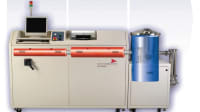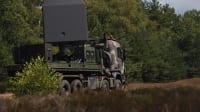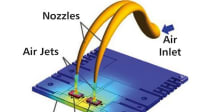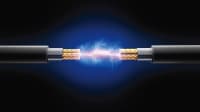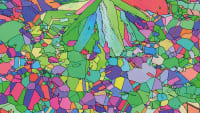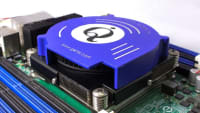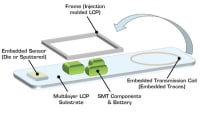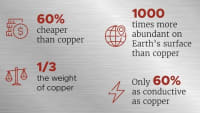Making a Material Difference in Aerospace & Defense Electronics

The aerospace and defense industries demand the highest levels of reliability, durability, and performance from their electronic systems. Central to achieving these standards are laminate materials, which form the backbone of printed circuit boards (PCBs) and flexible circuits used in a multitude of applications, from avionics to missile guidance systems.
Building these systems, which are typically implemented in environments that experience both temperature extremes and wide variations of temperature over time, requires robust materials that can stand up to punishing environmental conditions. Laminates and films for circuit boards and flexible circuits are a vital component of this protective material profile.
This article will delve into the challenges associated with building boards for these systems and the materials selection requirements that designers, OEMs and fabricators should consider. Illustrative examples of proven DuPont laminate and film products will be cited.
What are Laminates?
Laminates provide the backbone for increasingly complex circuits built on both rigid and flex substrates. They provide mechanical integrity to flex circuits while allowing designers the freedom to fit circuits into the available footprint.
Laminate materials are composites consisting of multiple layers of substrates, adhesives, and conductive metals, typically copper. The substrate often involves materials like polyimide, fiberglass-reinforced epoxy resin (FR4), or PTFE (polytetrafluoroethylene), each chosen based on specific requirements such as thermal stability, electrical insulation, and mechanical strength.
Board materials are a key factor in electronic system development. Their selection is dictated by the system’s desired functionality and performance requirements; in turn, the choice of board and application drives laminate and film selection. Regardless, the board chosen must deliver consistent functionality, through-hole consistency, and the ability to withstand temperature extremes.

All of which underscores the most critical factor – longevity. Because board swap-out in these applications is often impossible, the board and associated materials must undergo vigorous qualification to ensure that they can perform reliably over much longer periods than required by consumer applications. Rigid boards, like the example shown in Figure 1, are well-known. Solid and inflexible in structure, they are made up of several different layers and are known for their durability, high density and cost-effectiveness. Alternatives to rigid boards offer properties that accommodate product design requirements rigid boards can’t.
Flex Circuits
Flexible circuits are critical to use when the circuit design requires lightweight 3D electronics (see example in Figure 2). Made on non-reinforced polyimide films, lighter-weight flex circuits are called for when form factor is an essential consideration. They enable use of 3D electronics, which is especially key for defense applications such as guided munitions, handheld radios, and airplanes, in which the design is pushing boundaries and packing a high amount of electronics into a small space. Flex circuits are an enabling factor for this trend toward miniaturization of electronics.

Another reason to use a flex circuit is when rigid boards can’t accommodate the form factor, e.g., the board is in a non-flat state (bent or folded), or the application involves motion and requires a non-rigid board in order to maintain stable connections. Handheld and space/aerospace devices are key applications for flex circuits. In the defense arena, they’re implemented to enable development of faster missiles or planes, communications infrastructure, and personal devices – particularly those used by soldiers to help lessen the physical burden they must bear.
Often a viable option to a flex circuit, rigid-flex boards are a hybrid construction that combines the stability of rigid PCBs with the benefits of flex circuits. Removing the connectors eliminates potential failure points, reduces weight, and saves space.
Rigid-flex boards are available in two main forms:
A separate flex circuit connecting two rigid boards, acting as a sort of hinge between them, which enables stacking of the layers when the flex circuit is bent; or
Rigid and flex substrates integrated together into a single electronic board.
They offer high reliability even when subjected to shock or extreme vibration. This makes these boards well suited for such high-reliability applications as aircraft instrumentation, communication systems, missile guidance systems, and space flight vehicles, to name a few.
Laminates play an important role in circuit boards’ performance. They are vital for establishing electrical properties and thermal limitations, providing mechanical integrity to flex circuits, and enabling circuits to be fit into the desired footprint.
Similarly, polyimide films serve several purposes. Key functions include serving as:
Base dielectrics, applied as a manufacturing guide on flex printed boards;
Coverlays to protect flexible lines on flex circuit; or
Stiffeners for flex and rigid-flex boards, providing stability without losing flexibility.
Properly chosen films and laminates deliver a number of important benefits for PCB development and fabrication, including electrical insulation, mechanical stability, miniaturization, signal integrity, and ease of manufacturing.
End Users
For all users, several key factors must be considered when choosing materials to be implemented in products for these applications.
Thermal stability and resistance. Aerospace and defense environments often expose materials to high temperatures. Laminates and films must exhibit excellent thermal stability to maintain performance and prevent degradation over time. They must not only be able to withstand extreme operational temperatures and changes in temperature without degrading; they must also provide sufficient heat dissipation to prevent overheating of components.
Electrical performance. Optimal electrical insulation and conductivity are crucial for the proper functioning of electronic systems. Materials with superior dielectric properties, including low dielectric constant and dissipation factor, are preferred to minimize signal loss and prevent electrical failures. High-frequency compatibility is another essential parameter for applications involving high-speed data transmission.
Chemical and mechanical properties. Laminate and film materials must endure mechanical stress, vibration, impact and sudden shocks without compromising their integrity. This requires high tensile strength and flexibility, which are vital to maintaining structural integrity. Additionally, the materials must resist exposure to harsh chemicals, moisture, and UV radiation. These properties help ensure electronic components’ longevity and reliability.
In addition, domestic suppliers require fast access to quality materials and the ability to build boards in U.S., rather than having them built overseas and shipped. U.S.-based polyimide film providers with established expertise in laminates and films offer a distinct advantage. As the only U.S. laminate supplier that makes and utilizes its own polyimide films, DuPont has brought unique Pyralux® laminates and Kapton® polyimide films to the aerospace and defense markets for more than 30 years.
As an example, Pioneer Circuits has a long history of collaboration with DuPont, spanning four decades of partnership with their technical and management teams. Dan Hansler, Senior Advisor, Technology and Engineering, elaborated: “Our joint efforts have brought to life numerous innovative design projects, culminating from the first-ever material development of non-copper adhesiveless laminates used in cryogenic satellite applications. A pioneering moment came with the Mars Rover Pathfinder, which utilized DuPont’s Pyralux AP material in what may have been the industry’s first qualified use of adhesiveless laminate in space [Figure 3]. Subsequent Mars Rover missions continued to incorporate our flexible circuitry, featuring long-clad materials from DuPont that extended up to 10 meters in length.”

Not only can these offerings help address the aforementioned selection considerations, but they have also been certified to meet their respective, required mil-spec standards, as well as the NASA outgassing specification (see Table 1).

Pyralux ML is the newest addition – a polyimide laminate product clad not with copper alone but using metal alloys. This new approach enables Pyralux ML to not merely resist heat, but to generate heat, enabling thermal management of temperature-sensitive devices, such as flexible printed circuits, sensors, heaters and thermocouples.
Aerospace Examples
Extremes of heat, cold and solar radiation are the norm in outer space. Pyralux laminates and Kapton films have been shown to provide superior performance for space and aeronautic applications. In addition to the Mars Rover, some examples include the following.
Space satellites. Kapton film and Pyralux laminate products have been implemented for more than 6,000 satellites worldwide, often in multiple functions on a single satellite. For example, Kapton film may be used for multi-layer insulation and wire wrapping, and to create multi-layer insulation blankets. Pyralux laminates may be used to create phased array antennae, flex circuit interconnects on solar panel backplanes, power-collection flex cables (see Figure 4), solar power bus bars, and flexible heaters.

James Webb Space Telescope. Launched in 2021, JWST allows us to study every phase of cosmic history. The sunshield “sail” attached to the telescope is made of five layers of ultrathin Kapton, thermally bonded together in a grid pattern of “ripstops.” The material separates the JWST observatory into a warm, sun-facing side (reaching approximately 400 °F) and a cool side (roughly -185 °F).
Drones. Defense drones made using Pyralux flex board materials are designed for fast, pop-up assembly. Shipped in pieces to a military base, they can be removed from their shipping containers in the deployment location and quickly put into use with little physical assembly required, as shown in Figure 5.

Guided munitions. Precision guided munitions are intended to hit a specific target while minimizing collateral damage. Pyralux flexible PCBs’ form factor is critical to joining components in guided munitions, delivering weight savings, broad temperature range and form factor flexibility that are ideal for these systems.
Soldier field wear. Troops deployed in the field wear helmets, body armor and other protective gear, as well as carry handheld devices for communications. DuPont laminates and films are widely used in military gear, enable these vital tools to be more durable, lighter in weight, heat resistant, and able to withstand harsh conditions, regardless of environmental extremes.
Conclusion
Laminate materials are indispensable in the manufacture of boards and flexible circuitry for aerospace and defense electronics. Their unique properties address stringent demands, ensuring systems perform reliably under extreme conditions.
Board fabricators, designers, and OEMs carefully select laminate materials based on a broad range of important factors, including thermal management, mechanical strength, electrical performance, and environmental resistance – often, guided by mil-spec requirements.
For more than four decades, DuPont has supplied its Pyralux laminates and Kapton films for these applications, during which time it has become the leading flex circuit material manufacturer. These products have never experienced a field failure, and the company’s longevity ensures long-term availability of materials for product developers.
As technology advances, the role of these materials will only grow in importance, driving further innovations and maintaining the high standards required for aerospace and defense applications.
This article was written by Richard Wessel, Applications Technology Manager, and Michael Crutchfield, Technical Service Senior Consultant, DuPont Interconnect Solutions (Wilmington, DE). For more information, visit here .
Top Stories
INSIDERDefense
![]() F-35 Proves Nuke Drop Performance in Stockpile Flight Testing
F-35 Proves Nuke Drop Performance in Stockpile Flight Testing
INSIDERMaterials
![]() Using Ultrabright X-Rays to Test Materials for Ultrafast Aircraft
Using Ultrabright X-Rays to Test Materials for Ultrafast Aircraft
INSIDERManufacturing & Prototyping
![]() Stevens Researchers Test Morkovin's Hypothesis for Major Hypersonic Flight...
Stevens Researchers Test Morkovin's Hypothesis for Major Hypersonic Flight...
INSIDERManufacturing & Prototyping
![]() New 3D-Printable Nanocomposite Prevents Overheating in Military Electronics
New 3D-Printable Nanocomposite Prevents Overheating in Military Electronics
INSIDERRF & Microwave Electronics
![]() L3Harris Starts Low Rate Production Of New F-16 Viper Shield
L3Harris Starts Low Rate Production Of New F-16 Viper Shield
INSIDERRF & Microwave Electronics
Webcasts
Energy
![]() SAE Automotive Engineering Podcast: Additive Manufacturing
SAE Automotive Engineering Podcast: Additive Manufacturing
Manufacturing & Prototyping
![]() A New Approach to Manufacturing Machine Connectivity for the Air Force
A New Approach to Manufacturing Machine Connectivity for the Air Force
Automotive
![]() Optimizing Production Processes with the Virtual Twin
Optimizing Production Processes with the Virtual Twin
Power
![]() EV and Battery Thermal Management Strategies
EV and Battery Thermal Management Strategies
Energy
![]() How Packet Digital Is Scaling Domestic Drone Battery Manufacturing
How Packet Digital Is Scaling Domestic Drone Battery Manufacturing
Materials
![]() Advancements in Zinc Die Casting Technology & Alloys for Next-Generation...
Advancements in Zinc Die Casting Technology & Alloys for Next-Generation...











